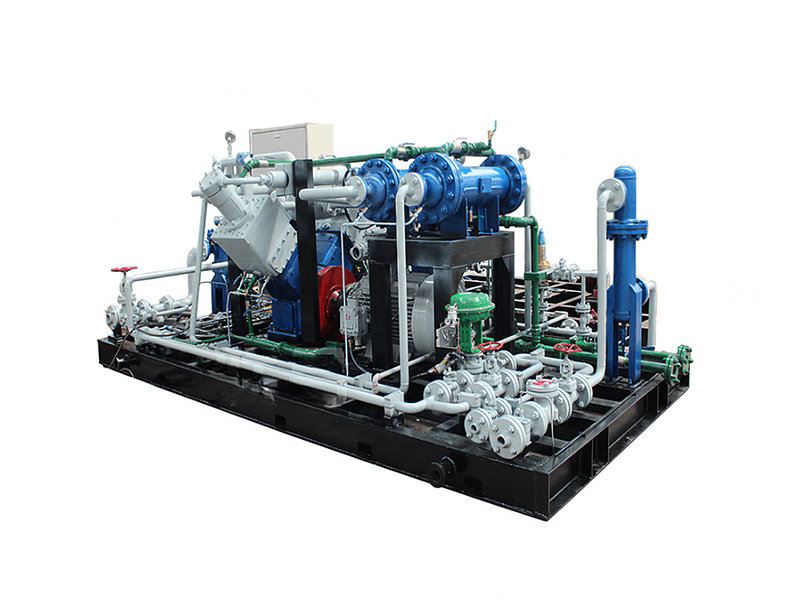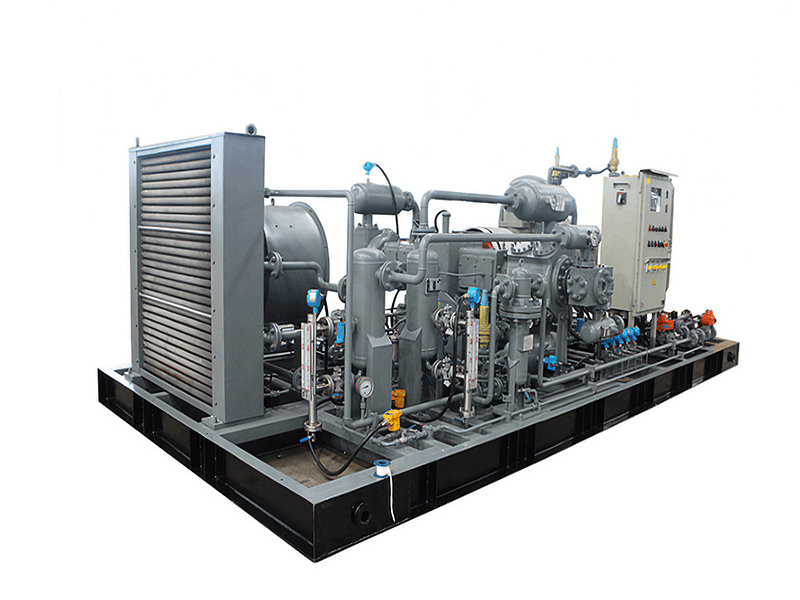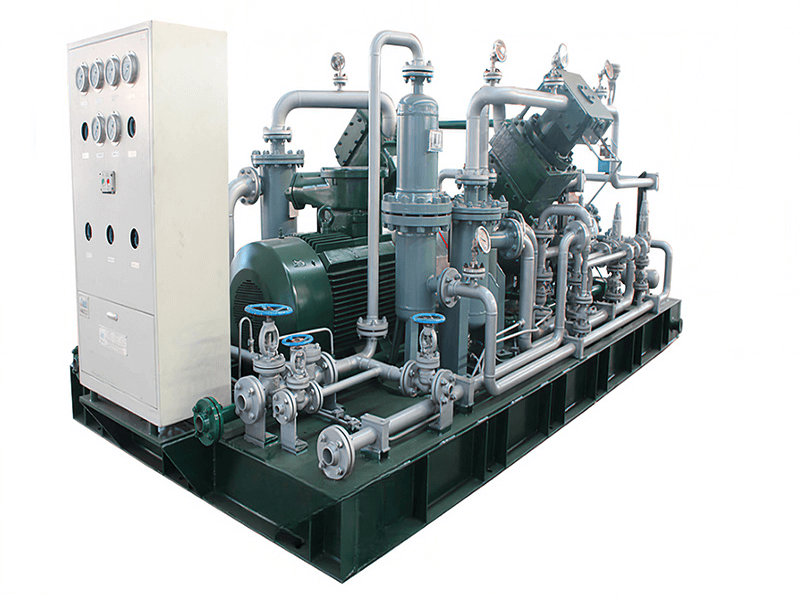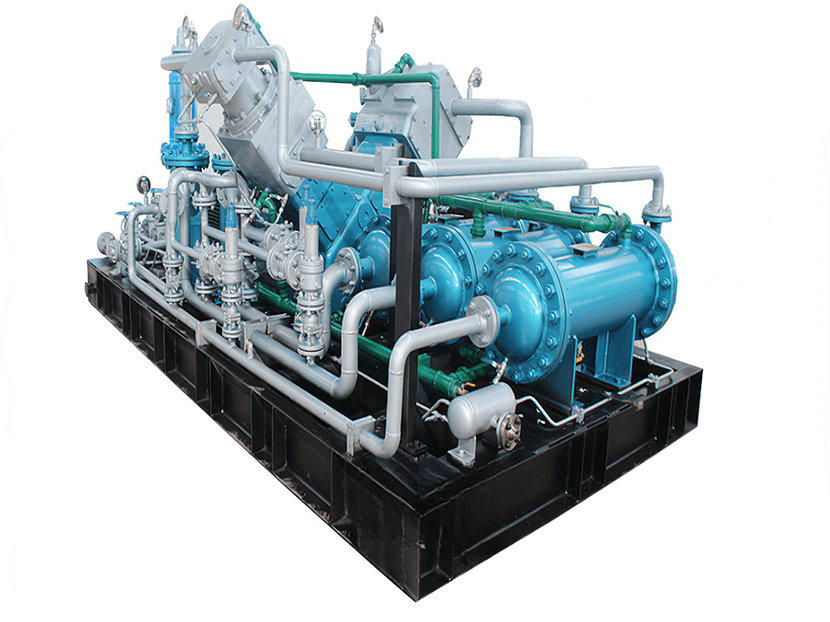Helium has become the core refrigerant in cutting-edge fields such as superconducting magnets, aerospace propulsion and quantum computing due to its extremely low boiling point (-268.9℃), superfluid properties and chemical inertness. In the helium cryogenic liquefaction system, the piston compressor undertakes the core task of pressurizing crude helium to 15~25MPa, and its sealing performance directly determines the energy efficiency, helium recovery rate and operational safety of the system. However, the diameter of helium molecules is only 0.26nm, the permeability is strong, and the material is prone to embrittlement under ultra-low temperature conditions. Traditional sealing technology is difficult to meet the needs of long-term operation. This article focuses on the special scenarios of helium cryogenic liquefaction, analyzes the innovative path of piston compressor sealing technology, and discusses its practical results in combination with typical engineering cases
I. Core Challenges of Helium Cryogenic Sealing
1. Material Failure in Ultra-low Temperature Environment
Low-temperature embrittlement: The toughness of metal materials drops sharply at -269℃, and sealing components are prone to microcracks due to shrinkage or vibration.
Thermal stress alternation: The drastic temperature changes caused by the start and stop of the compressor (normal temperature ↔ liquid helium temperature zone) accelerate seal fatigue.
2. High permeability of helium molecules
Complex leakage path: Helium can penetrate through the gap of the sealing surface, the material lattice and even the vacuum adsorption layer. The annual leakage rate exceeds 5%, which will significantly increase the operating cost.
Dynamic seal failure: The reciprocating motion of the piston rod under high pressure (≥20MPa) aggravates the seal wear, and the leakage volume increases exponentially with the running time.
3. Cleanliness and compatibility requirements
No oil pollution: Lubricating oil solidifies or carbonizes at low temperature, and a fully oil-free seal design is required.
Impurity sensitivity: Trace oxygen and nitrogen impurities will increase the liquefaction temperature, and the sealing material must avoid releasing particulate pollutants.
2. Key innovation directions of sealing technology
1. Material system innovation
Base material:
Metal substrate: Austenitic stainless steel (316LN) and nickel-based alloy (Inconel 718) have an impact toughness of >80J at -269℃ and excellent hydrogen embrittlement resistance.
Non-metallic materials: Polyimide (PI) and polyetheretherketone (PEEK) based composite materials can withstand low temperatures and have a friction coefficient as low as 0.08.
Surface strengthening technology:
Coating process: Piston rod spraying diamond-like carbon (DLC) or titanium nitride (TiN) coating, hardness ≥ HV2000, helium permeability reduced by 90%.
Ion implantation: Tungsten ions are injected into the sealing surface to form a nanocrystalline barrier layer to inhibit helium diffusion.
2. Optimization of sealing structure
Combined sealing system:
Main seal: metal bellows + flexible graphite ring, dynamic compensation for cold shrinkage deformation, and tolerance to 20MPa pressure difference.
Secondary seal: labyrinth seal + magnetic fluid seal, forming a multi-level leakage barrier, leakage rate ≤1×10⁻⁹ Pa·m³/s.
Non-contact seal:
Gas bearing seal: Use high-pressure helium to form an air film to achieve zero friction sealing, and extend the service life to 100,000 hours.
3. Intelligent monitoring and adaptive compensation
Online leak detection system:
Helium mass spectrometer leak detector: sensitivity up to 1×10⁻¹² Pa·m³/s, real-time positioning of leak points.
Fiber optic sensor network: Fiber Bragg grating (FBG) is arranged in the sealing cavity to monitor temperature and strain distribution.
Adaptive compensation technology:
Hydraulic active compensation: Dynamically adjust the sealing ring clamping force according to the leakage signal to maintain a constant sealing gap.
Shape memory alloy (SMA): Utilize the low-temperature phase change characteristics of Ni-Ti alloy to automatically compensate for cold shrinkage deformation.

III. Analysis of typical application cases
Case 1: Large Hadron Collider (LHC) of European Organization for Nuclear Research (CERN)
Background: LHC needs to maintain a 1.9K superfluid helium environment, and compressor seal failure will result in hundreds of millions of euros in losses.
Technical solution:
Sealing structure: Four-stage metal bellows + graphite ring combination seal, supplemented by helium purge to isolate oil pollution.
Material innovation: The piston rod adopts silicon carbide fiber reinforced aluminum-based composite material (SiC/Al), and the thermal expansion coefficient matches the cylinder.
Monitoring system: integrated 64-channel fiber optic sensor, leak positioning accuracy ±5mm.
Achievements: 12 years of continuous operation, cumulative leakage rate <0.1%/year, ensuring zero interruption operation of the collider.
Case 2: Helium liquefaction plant of the National High Magnetic Field Laboratory (NHMFL) of the United States
Challenge: 200 tons of helium are liquefied annually, and the sealing system needs to withstand frequent start-stop (10 times per day on average) and low temperature of -268℃.
Innovative design:
Non-contact sealing: using air film bearing seal, helium consumption is reduced to 0.5m³/h.
Intelligent compensation: using shape memory alloy (Ni-Ti-Nb) to automatically adjust the sealing gap, with a compensation range of ±0.3mm.
Digital twin: building a virtual model of the sealing system, with an accuracy rate of >95% in predicting maintenance cycles.
Benefits: the replacement cycle of seals is extended from 6 months to 3 years, and the annual maintenance cost is reduced by 40%.
Case 3: China Mianyang Fusion Engineering Test Reactor (CFETR) Helium Cryogenic System
Requirement: Provide 15K/3MPa helium for nuclear fusion devices, and the sealing system needs to resist neutron irradiation damage.
Solution:
Irradiation-resistant material: The sealing ring uses yttrium-stabilized zirconia (YSZ) ceramics with a radiation dose resistance of >10¹⁹ n/cm².
Dual redundant design: When the main seal fails, the magnetic fluid seal is automatically activated, and the leakage rate is <1×10⁻¹⁰ Pa·m³/s.
Remote operation and maintenance: Real-time transmission of sealing status data through 5G network, supporting unattended operation.
Results: The system has passed the ITER international certification, and the helium recovery rate is >99.5%.
IV. Industry Challenges and Future Trends
1. Adaptability to extreme working conditions
Challenges: The demand for liquid helium for deep space exploration (-271℃, 30MPa) puts higher requirements on sealing materials.
Trend: Develop nanoporous metal (such as MOF-74) coatings, and reduce the helium permeability to 1×10⁻¹³ Pa·m³/s.
2. Improved economic efficiency
Challenge: The manufacturing cost of high-precision sealing components accounts for 30%~40% of the total cost of the compressor.
Trend: Promote additive manufacturing (3D printing) technology, integrate complex sealing structures, and reduce costs by 50%.
3. Intelligent upgrade
Challenge: Traditional leak detection technology has a slow response speed and is difficult to prevent sudden leaks.
Trend: Integrate quantum sensors and AI prediction algorithms to achieve leak precursor identification and self-repair.
Conclusion
The piston compressor sealing technology in the helium cryogenic liquefaction system has significantly improved the reliability and economy of the system through the deep integration of material innovation, structural optimization and intelligent monitoring. The successful practice of projects such as CERN, NHMFL and CFETR shows that combined sealing design, non-contact sealing and adaptive compensation technology can effectively cope with the challenges of ultra-low temperature, high permeability and extreme working conditions. In the future, with breakthroughs in nanomaterials and intelligent algorithms, sealing systems will evolve towards zero leakage, self-sensing and long life, providing solid support for the helium energy economy and large scientific facilities.

























